
Caftans, long, loose-fitting tunics with origins in ancient Persia, have been gaining momentum as an alternative to more structured formal dress. With any luck, there will be some caftans among the goddess gowns at tomorrow’s Academy Awards ceremony.
They say Tsarina Alexandra was the first westerner to make a fashion statement in a caftan, when she dressed as a seventeenth-century Tsarina for a costume ball in 1903. Paul Poiret also advanced the caftan cause, but it was not until the 1950s that the garment really began to influence western fashion. Here’s a look at caftan patterns from the 1950s to now.


1950s
In the mid-1950s, Christian Dior and Cristóbal Balenciaga’s experiments with silhouette were partly inspired by eastern traditional dress. Dior’s Fall 1955 couture collection (Y line) included caftan-inspired ensembles—coats with high, side-front slits that reveal a slim dress underneath:


You can see echoes of the Dior caftan look in contemporary sewing patterns like McCall’s 3525 and 3532, both from late 1955:

McCall’s 3532, called a “slim caftan-and-dress ensemble,” was featured on the cover of McCall’s news leaflet and in the company’s “Make the Clothes that Make the Woman” advertising campaign. According to the ad, the design is ideal for the season’s “Oriental” fabrics, such as silk twill and raw silk tussah:


A Vogue version of the Dior caftan ensemble, Vogue 8759, is available as a reproduction from EvaDress.
1960s
Caftans became popular in the 1960s in tandem with the increasing interest in eastern cultures. The Madame Grès version at the top of this post is cut on the bias, producing geometric seaming detail. The caption reads, “Coup of bias-work by Grès—because this piecing-together of bias angles is sinuous, stark, ravishingly Moroccan.”
This dress from Jean Patou by Michel Goma, Vogue 1699, has what the envelope calls a “caftan neckline.” The model is Beate Schulz:

This circa 1968 Vogue caftan pattern has optional flexible trim:

Other patterns from the late 1960s and early 1970s also reference eastern dress. From 1967, McCall’s 9026 is labelled as an abba in two lengths. Abba is an alternate spelling of aba, commonly abaya: a traditional Arab garment, long, loose-fitting, sleeveless, and made from a single rectangle of fabric. (Today, caftans often function as abayat.) The model is Veronica Hamel:
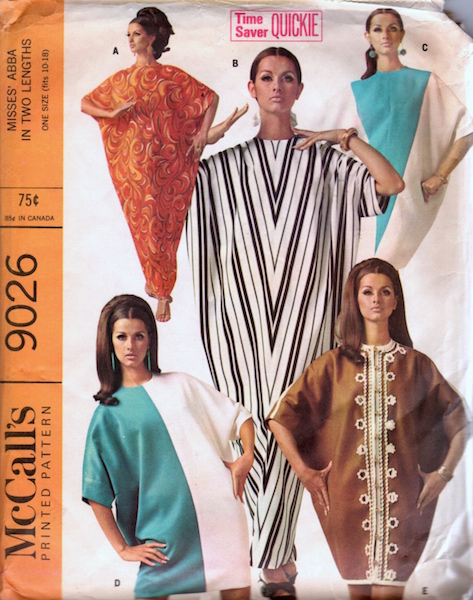
Burnoose patterns were marketed as resort wear. A pompom-trimmed version of McCall’s 2377 was photographed for the cover of McCall’s Summer 1970 catalogue:

Marola Witt models Simplicity’s burnoose in the July 1967 issue of Simplicity Fashion News. (Thanks to Mary of PatternGate for the reference.) The text promotes the design’s ‘Arabian’ exoticism: “be exotic in a JIFFY: … the burnoose, born in Arabia, brought up to date here”:
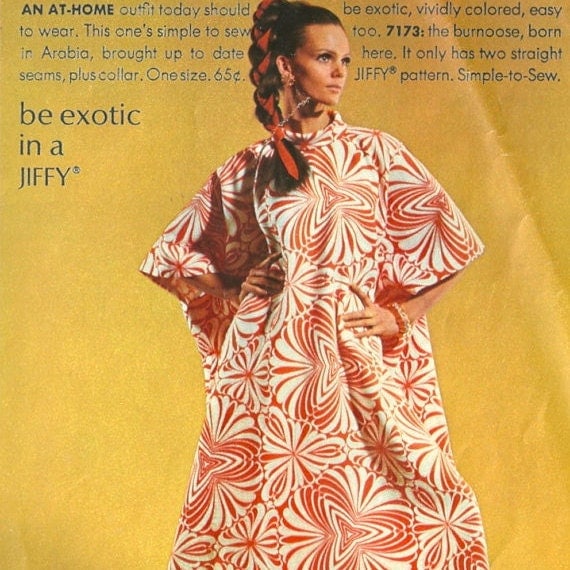
1970s
This Halston caftan pattern from McCall’s also includes a top and pants (you can buy yourself a copy from the shop):

This flowing Dior caftan, modelled by Billie Blair, has lots of neckline detail, full-length sleeve openings, and pockets:

Vogue 1515 by Nina Ricci is a caftan that’s open in front and attached at the neckline to a handkerchief-hemmed underdress:
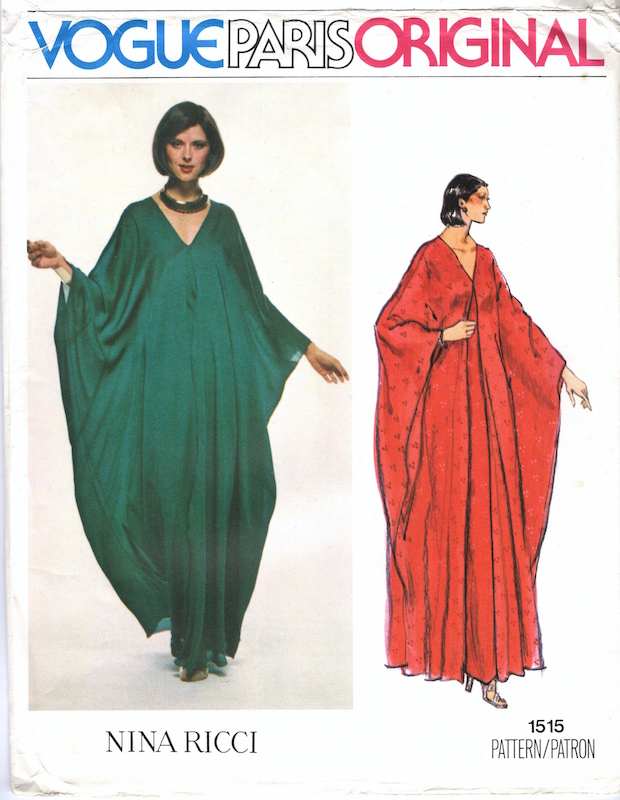
1980s
It’s harder to find post-1970s designer caftan patterns. This wide-sleeved, Oscar de la Renta caftan is trimmed with contrast bands. When worn, the side seams swing forward to raise the hemline in front:
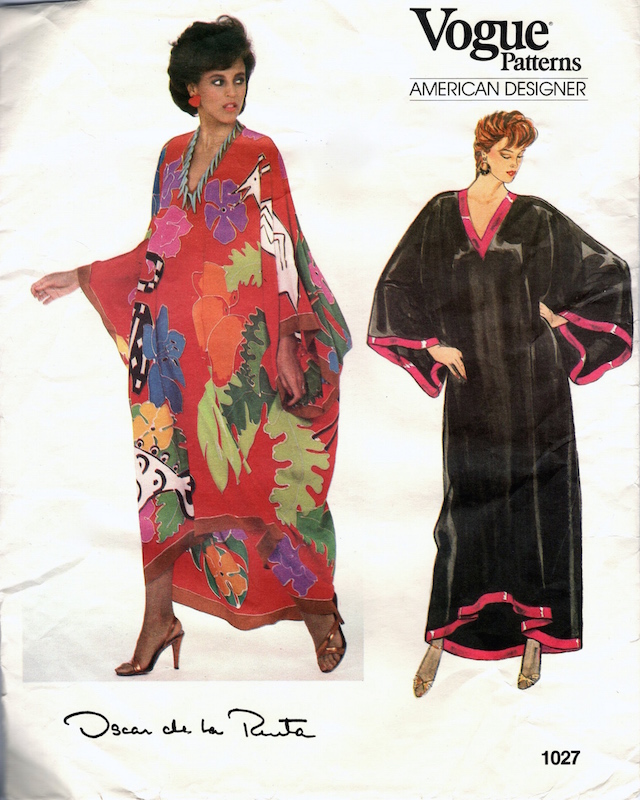
1990s
From Issey Miyake, Vogue 2315 is a caftan-inspired summer dress:

2000s
Caftan patterns started making a comeback (of sorts) in 2009. Simplicity 2584, a caftan-inspired tunic by Cynthia Rowley, is out of print but still in demand:
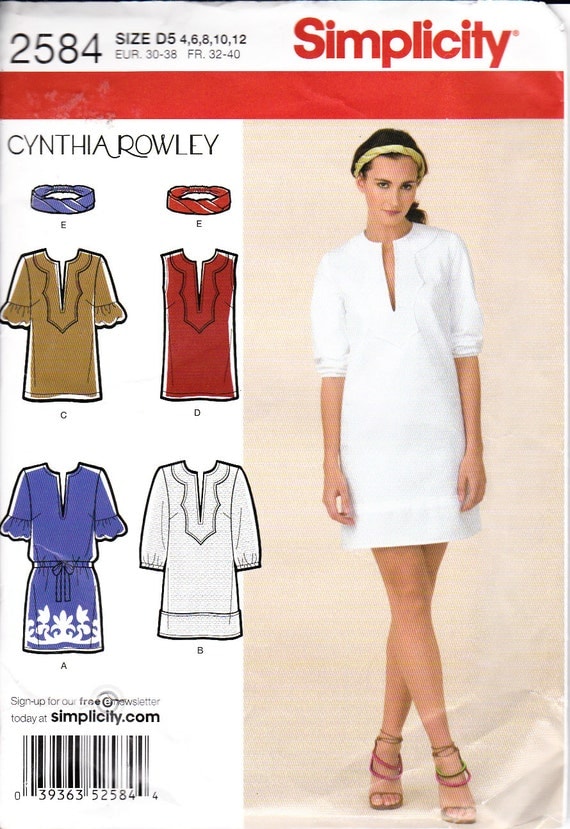
Ralph Rucci’s floor-length caftan, Vogue 1181 (now out of print), has an abaya silhouette and interesting construction details—overarm darts, shaped lower sections, and a hook and eye above the low neckline:

The design is from Chado Ralph Rucci Resort 2009:

Matthew Williamson’s short caftan, available as a free pattern from the Guardian, is also a 2009 design:

And Heather Lou’s printed chiffon caftan is a Fashion Star pattern by Nikki Poulos, McCall’s 6552 (now out of print):

Would you sew a caftan?
I love this post. So interesting and well researched. A caftan is a great way to let the fabric speak.
Aren’t those patterns with bands at the neck inspired by the Indian kurta? Or maybe they all go back to the same inspiration.
I bought several ‘Turkish towels’ in Istanbul with the intention of making something like mccalls 2377. I even bought the pattern off an etsy seller about a year ago as a house robe/beach coverup. In the Middle East Gulf states, similar things are quite common as around-the-house clothes (in contrast to the flowing black abayas for women or the crisp white dishdasha for men). But so far I’ve done nothing about making the actual thing! Maybe this reminder will push me there. Fun post.
I made a fabulous caftan in the early 1970s (don’t remember which pattern) and wore it for years and years. It had a very large scale geometric print on a poly silky and the caftan was ideal for showcasing the fabric. I’ve also made caftans as part of dance costumes, but that was in a traditional Middle Eastern mode, not a Western one.
My favorite is the white Nina Ricci dress.
Well done — It’s not always easy to decide what is a caftan and what is not. (I just read Harper’s Gallery of caftans). I associate the 1960s glamor caftan with movie star Elizabeth Taylor. A search for “Elizabeth Taylor caftan” will bring up lots of images.
The patterns and images you chose for this blog posting were wonderful for showcasing the broad range encompassed by ‘caftan’ in apparel from dramatic and elegant to the beach fun cover-up. I thoroughly enjoyed the entire presentation, particularly the Chado RR images.
I had a lot of those, still like them! 🙂
What a great variety of caftan you have shown us, isn’t it great that they are popular at the moment?
A caftan certainly would give you the opportunity to show off some beautiful fabric! Interesting post! Thank you!
I’m loving caftans this year. They’re so effortlessly elegant, and the idea of all that gorgeous fabric enveloping the body and gliding over curves is delicious. I’m definitely going to be making a few from a vintage 1970s pattern I bought off Etsy for this summer.
Made myself a very cool caftan in 1970 as a beach coverup, like pattern 9026 or the one following, without the burnoose hood. It was great, extremely comfy, wish I had it now. And it protected my very sunburn prone skin from the California sun, where we had just moved.
Maybe I need to do something like this again…